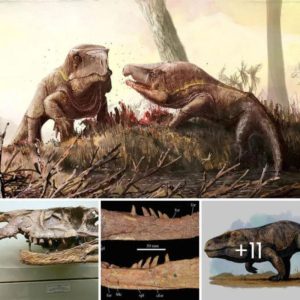It might be the world’s oldest soft tissue sample. In the ribcage of a dinosaur that walked the Earth 195 million years ago, researchers discovered ancient collagen and protein remnants preserved.

No, this does not imply that “Jurassic Park” will be made into a movie. However, discovering such well-preserved organic remains from a Lufengosaurus, one of the earliest dinosaurs, is unique. “This discovery expands the record of preserved organic remains by over 100 million years,” the researchers said in their Nature Communications paper. Taiwan, China, and Canada were among the researchers.
Collagen pieces discovered previously dated back 75 million to 80 million years. The newly found collagen’s position was also unexpected. “Usually, people seek for collagen in the enormous, gigantic limb bones, not in the more fragile ribs,” said Robert Reisz, a paleontologist at the University of Toronto Mississauga and one of the study’s authors.
Collagen is a protein that is found in connective tissues and the skin. The collagen and protein identified in the microscopic vascular canals of the rib are thought to be the remnants of blood vessels in this case, according to the researchers. This is where the dinosaur’s blood arteries, blood, and nerves would have been stored while it was living.

The vascular canals also included hematite samples, which were depicted by dark red dots. Hematite is a mineral made from iron-rich hemoglobin, a protein molecule found in red blood cells that delivers oxygen from the lungs to the tissues.
According to the researchers, the hematite came from hemoglobin and other iron-rich proteins in the dinosaur’s blood, functioning as a preservative for the collagen. They can learn more about the early phases of dinosaur evolution by studying these materials.
Instead of taking samples and dissolving away sections of the fossil, as in prior investigations, the researchers concentrated on preservation and employed noninvasive imaging techniques such as spectroscopy and microspectroscopy.
This also made it less likely that the sample would get infected with contemporary microorganisms. Lufengosaurus is one of the earliest dinosaurs from the early Jurassic era, having lived between 190 million and 200 million years ago.
It had a lengthy neck and a body that reached around 26 feet, indicating that it spent some time walking on two legs. Lufengosaurus was most likely a vegetarian, despite its strong teeth and claws. It was a sauropodomorpha, a plant-eating dinosaur with a long neck and lizard-like feet.

Their fossils, as well as nests holding embryos, are most typically found in Lufeng, China’s Yunnan Province, where they were named. In 2013, the “bonebed” of nests full of embryos, as well as preserved organic remnants, was discovered by several of the same researchers from this study.
“We had some evidence of organic remnants in the embryos before,” Reisz said, “but we didn’t really have any precise information on those organics.” The researchers believe that their discovery will allow them to locate other ancient proteins that have been conserved and study them in a way that will help preserve them.





